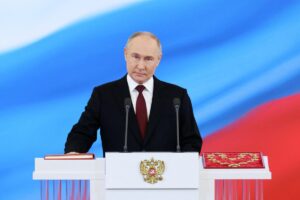Russia’s Currency Crisis: An In-Depth Look at the Financial Turmoil
In an aggressive move to tame soaring inflation, the Central Bank of Russia has suspended all foreign currency purchases for the remainder of 2023. This decision comes in the wake of the ruble hitting alarming lows, now trading at less than a penny against the dollar—an unprecedented situation since the onset of the Ukraine conflict. The central bank’s strategy includes selling off Chinese yuan to stabilize the ruble, a move aimed at counteracting the inflationary pressures that threaten the domestic economy.
The current economic landscape in Russia is stark. Official inflation figures have surpassed 9% year-on-year as of August, but some experts, including political scientist Kirill Rogov, suggest these numbers significantly underrepresent the reality. Analysts from Raiffeisen Bank and research firm ROMIR fear actual inflation rates could be considerably worse, driven by a grim combination of factors, including western sanctions and reduced foreign investment.
The sanctions landscape is critical, especially after the recent U.S. imposition of sanctions against Gazprombank, previously exempt due to its role in Russian natural gas exports. This regulatory environment restricts Russian financial institutions from trading in U.S. dollars, thereby limiting the country’s ability to replenish its reserves and further straining the ruble.
On Wednesday, the ruble plunged past the 114 mark against the dollar, its lowest since March 2022, leading to descriptions of a "panic attack" in Russia’s currency markets. While the Finance Minister Anton Siluanov contends that a weakened ruble could benefit exporters by making their goods cheaper for foreign buyers, the realities are more complicated. A weak currency may lead to imported inflation, raising prices for essential foreign goods and compounding the financial distress for Russian consumers.
The repercussions of Putin’s military mobilization have reverberated through the economy, as a significant influx of working-age males into the military has led to labor shortages in civilian sectors. The resulting scarcity has driven wages upward, exacerbating inflation as companies transfer rising labor costs onto consumers. The current unemployment rate stands at an unprecedented low of 2.4%, and according to Central Bank Governor Elvira Nabiullina, "all production facilities are working at full capacity," a clear sign of stress on the economy.
Price hikes have affected everyday staples disproportionately. The price of potatoes has nearly doubled since last December, and essential items like butter have become so costly that some retailers are locking up stock to prevent theft. The government’s withdrawal of mortgage subsidies in July has also drastically increased borrowing costs, pushing families to the financial brink.
In response to these spiraling economic woes, the Central Bank raised the prime interest rate by two percentage points to 21% in October, a level not seen since 2003. Yet this bold move has so far failed to slow inflation or stabilize the ruble. In fact, financial analysts from Russian business daily RBK have advocated for rates to reach an eye-watering 30% to 40% to control the economic fallout—even at the potential cost of slowing growth.
However, not all voices are aligned on this approach. Severstal Chairman Alexey Mordashov warned that elevated borrowing rates are crippling businesses and achieving little progress. Speaking to Politico, he remarked, "This is a situation probably without precedent in modern world history… it’s as if the medicine is more harmful than the disease."
The current financial crisis in Russia may ultimately shift international dynamics, potentially providing incoming leadership in the U.S. with leverage to renew negotiations with Moscow. Recent developments indicate a heightened global anxieties regarding military escalation, with Russia unveiling an experimental MIRV intermediate-range ballistic missile capable of carrying multiple warheads, further complicating an already tense international situation.
As the situation evolves, it’s essential to stay informed about the economic and political implications of Russia’s financial strategies and the broader effects on the global economy. For more insightful analysis on finance and investment, continue exploring the Extreme Investor Network, where we delve deeper into the intricacies shaping the financial world today.

